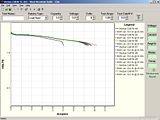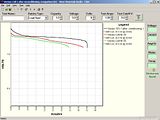My battery no longer likes to take a full charge. Sometimes it will quit in less than a minute, other times it will charge the full 2+ hours without interruption. Usually it takes a few tries before it takes a full charge. The battery has taken me over 3,000 miles and 300 charge-discharge cycles.
I think the battery has a lot of life left, it just needs to be reconditioned. The MH-C777 might do the job if it supported my 30-cell, 36V battery pack (it only supports up to 12 cells, 14.4V). I don't really want to break the individual batteries out of the battery pack, charge them individually, and then solder them back together again.
Does anyone know of or has anyone built a battery conditioner for the Crystalyte battery pack that doesn't require disassembling it? (P.S. the pack has an Anderson connector to the motor and an XLR socket for charging.)



In my experience there is no need to disconnect the cells from each other. They can be both discharged and recharged by making a temporary (clip on) connection to individual cells. You could also solder tap wires on and leave them in place for next time. The connection does not need to be very good if you only want to recondition the cell with the 300mA discharge current that the MH-C777 uses.
I don't think you can recondition the cells in series.
The cells are bound to have different capacities, that's why you cannot recondition them as a string. You would reverse charge the weaker cells and damage them further.
A CBA2 can be used for this purpose.
I found that after very deep discharges NiMH cells cannot take the full charging current immediately. They need to be charged at a lower rate for a little while, then they can handle the full charging current again.
I guess that is what happens in your pack when it cannot be charged on first attempt:
Several cells have been totally emptied and charged in reverse for a while before the LVC was reached. They "refuse" to let sufficient current pass when you start charging them, and the charger turns off. Once you have charged them a little bit, their IR for charging drops and then you can charge normally.
But you might also find that those cells will be full before the cells with good capacity and therefore they heat up more than the others at the end of charging. This gradually damages them further.
The trick is to limit the demand on the pack to what the weakest cell can handle, or replace the weakest cells if they are very different from the others.
In any case, you need to make some measurements at the cell level to find out which ones are problematic.
Expose the tabs and put the pack on a light load when it's "Empty". You will find that some cells are being charged in reverse whilst the majority are still far from empty. Those cells are the ones you need to concentrate on, either replace them or recondition them.
What is the nominal capacity of your pack? You might find that the MH-C777 is too inflexible with it's fixed 300mA discharge current. I could also not find which cutoff voltage it uses. You will get much better results with a CBA2 where you can set both the current and the cutoff voltage. C/20 or less and a cutoff voltage of 0.43V worked well for my Vectux cells:
This shows the results for one of the 8-cell modules on initial testing:

And this shows the effect of reconditioning on a good cell:

The green curve is from a cell during first testing. The red curve is from the best cell in the whole 102 cell string on first testing. The black curve is from a cell after reconditioning. This cells initial testing had been very similar to the green curve during first testing (but I do not have an uninterrupted discharge curve for it).
It means that an average cell can get back to be better than the best cell in the string - but only with good reconditioning.
Unfortunately the capacity increase seems to be a function of the capacity available before reconditioning. The capacity increases by 12% - 20%, which means that the imbalance between strong and weak cells gets even larger!
But the overall capacity of the string will increase.
This information may be used entirely at your own risk.
There is always a way if there is no other way!
Mik, thanks for the information. It sounds like I will pretty much have to separate the cells anyway in order to replace the bad ones.
Here is another charger option:
RT-808D
http://www.infinity-hobby.com/main/product_info.php?products_id=3410
I bought one but have not tested it yet. It claims to have a lot of features, including adjustable discharge rate and cutoff voltage. (0.1A to 1.0A and 0.1V to 25.0V cutoff.)
You can measure your cells and recondition them without desoldering. If it turns out to be necessary to take them apart you can still do it later, and only those connections that really need to be taken apart.
It really depends on how much time and how much money you have; and most importantly, how much you want to learn about the batteries!
It will take a lot of time to analyze and recondition and rebuild the pack. If you are time poor and cash rich, don't do it! Unless you want to develop a much deeper understanding of NiMH battery care.
This information may be used entirely at your own risk.
There is always a way if there is no other way!